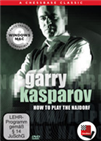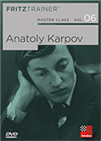In a previous article — Kasparov–Karpov: The Secret of the 24th Game — we invited our readers to share their thoughts on the 24th game of the 1987 World Championship match in Seville. This encounter is among the most thrilling games in all World Championship matches from 1886 to the present day, and can be rightfully compared to the famous Game 23 of the 1951 match between Botvinnik and Bronstein (which we also analyzed in this column — Botvinnik vs. Bronstein 1951: Bronstein Could Have Drawn). One should not overlook Game 14 of the Kramnik–Lékó match 2004 (although it was not played under FIDE’s auspices). In all of these games, the player with the white pieces had to win in order to level the score (with a minor distinction in the Botvinnik–Bronstein case, as that was the penultimate game of the match). Curiously, in each of these cases, White succeeded in doing so.
 Between 2004 and 2007 the 13th World Champion Garry Kasparov recorded a large 3-volume Najdorf video course. ChessBase is publishing this great classic in a complete edition in the current ChessBase Media format. Look forward to this classic of chess!
Between 2004 and 2007 the 13th World Champion Garry Kasparov recorded a large 3-volume Najdorf video course. ChessBase is publishing this great classic in a complete edition in the current ChessBase Media format. Look forward to this classic of chess!In analyzing this game, I consulted the following sources:
- Kasparov, Kasparov on Modern Chess, Part III, Everyman Chess, 2009.
- Timman, The Longest Game, New In Chess, 2019.
- Kasparov, Garry Kasparov on Garry Kasparov, Part II, Everyman Chess, 2013.
From a purely chess standpoint, our game is not particularly remarkable—in terms of quality (across the five matches between Kasparov and Karpov, there are truly brilliant games that deserve the highest accolades). Some serious errors were committed by both sides, but considering the exceptional psychological strain on the players during this encounter, such mistakes are entirely understandable.
Although White emerged from the adjournment with an extra pawn, the key question remained: was this sufficient for a win, given that the play was confined to one side of the board—an element that typically enhances the drawing chances of the defender? As mentioned in the previous article, only Kasparov, during post-game analysis, expressed a degree of doubt, suggesting that one particular variation might not yield a win for White. All other analysts known to me have asserted that White should win with precise play, though not without difficulty. Timman also supports this view in his excellent 2019 book The Longest Game, devoted to the Kasparov–Karpov encounters.
In our prior article, we posed a question to our readers: was this truly the case? Did Black have no practical chances to save the game after the adjournment?
In this article, we provide the answer: with accurate defence, Black could in fact have held the draw after the adjournment. Of course, we speak here purely in theoretical terms—practical play is another matter entirely. According to Kasparov (source 1), Karpov believed that his position was lost, and this is one of the reasons why, following the adjournment, he capitulated rather quickly and without much resistance.
Let us now examine the conclusions that emerge from a new analysis of this memorable encounter. A few questions were posed to our readers, to which we now provide detailed answers. These questions are significant for a deeper understanding of the game, and commentators up to this point have offered differing interpretations.
The first question was: Did the move 33...Ne7 lose the game, given that it was Karpov’s only clear mistake prior to the adjournment?
It should be noted that this move indeed loses the game — if White responds with 34.Bh5. However, Kasparov assessed his actual move 34.Qd8 as “dubious” (though not a mistake), and Timman offered no evaluation at all, which suggests that neither believed White had missed a win at that moment. According to a fresh analysis, however, White did miss a win here, because the position at the time of the adjournment could theoretically have been held with accurate defense. In other words, the move 34.Bh5 would have secured the win, and its omission must be classified as a mistake.
The second question was: Kasparov states that the move 42...g5 was weak, illustrating the line: “43.f4! Qf6 44.Kh3 gxf4 45.exf4, etc.” Was Kasparov right?
Answer:
 On this DVD a team of experts looks closely at the secrets of Karpov's games. In more than 7 hours of video, the authors examine four essential aspects of Karpov's superb play.
On this DVD a team of experts looks closely at the secrets of Karpov's games. In more than 7 hours of video, the authors examine four essential aspects of Karpov's superb play.
-
It is difficult to assert definitively whether 42...g5 loses the game, but it is clear that after 43.f4, the position is no longer lost. Black obtains strong counterplay following 43...Qa3 (or 43...Qa7 with the same idea). White might instead try 43.Bf3, but even then, a precise defense by Black would likely hold.
-
The move 44...gxf4 is certainly not the best continuation for Black, though it probably does not lose by force. After the stronger 44...Qc3, Black may be able to save the game.
-
The final position from Kasparov’s line after 44.exf4 indeed appears grim for Black. However, further analysis shows that even this position is not lost, although precise play is essential to hold the draw.
It is also worth noting that Kasparov analyzed the alternative move 42...Qf6, offering the line 43.h4 g5 44.h5, and commented: “True, I am still not sure whether this was good enough to win.” In this, he was correct — the position is equal.
The next question concerns Timman’s analysis. In his excellent book The Longest Game, Timman presented the line with 34.Bh5 as winning, but did not consider Kasparov’s move 34.Qd8 a mistake. On the contrary, he described it as “the clearest path.” This suggests that he believed Kasparov’s position remained winning throughout. As confirmation of his view, Timman provided an alternative line beginning with 45...Nd7 instead of the obviously inferior 45...h5, which was played in the game.
Let us consider the conclusions:
- According to my analysis, the move 45...Nd7 in fact loses. The game analysis presents several continuations that could have preserved the balance.
- Timman’s next suggested move, 46.Qd6, is in fact an inaccuracy that allows Black to equalize. The more precise 46.Qc7 would have preserved winning chances, although accurate play would still be required to convert the advantage.
- Black’s reply 46...Nf6 is another mistake, once again leading to a lost position. The better defensive move was 46...Nf8, after which Black could still hold.
- White’s move 47.Bf3 constitutes yet another inaccuracy. With the stronger 47.Bc2, White could have maintained winning prospects.
- Black’s 47...Qd7 is a mistake that loses the game. Alternatives such as 47...Nh7 or 47...Nd7 would have offered realistic chances for a draw.
- White’s 48.Qc5 is another error, allowing the position to become equal. The stronger 48.Qb8 would have preserved White's winning chances.
- Black then errs with 48...Kf7. The more tenacious 48...Nh7 would have improved Black's drawing prospects.
- White’s next mistake is 53.Qe4. Instead, the immediate 53.Qa7 would have secured a winning position.
- Finally, 54...Nc5 is the last inaccuracy in this segment of the analysis. The better defensive move 54...Nf8 could have led to a draw.
How could Black have saved the draw?
Instead of the undoubtedly decisive error 45...h5, Kasparov himself suggested 45...Qf6 as the more tenacious option. In fact, this move holds the position. Interestingly, Kasparov made a serious analytical oversight: his suggested 48...Ng6, after which he claimed Black could still resist, actually loses in a fascinating queen endgame. The drawing move was 48...g4.
It should also be noted that Black had several other viable drawing options, including 45...Kg7, 45...Qg7, and 45...Qd7. All this evidence confirms that the position at the adjournment was not necessarily lost, and that with precise play, Black could have held.
Replay the analysis
In the replayer below the game is presented in two formats: For those less inclined toward lengthy analysis, the first version includes the key moments with brief comments and conclusions.
For those who enjoy deeper analysis, the second version provides extensive commentary, including studies of specific endgame types (e.g., queen endgames, bishop vs knight endings), offering a chance to refine one’s understanding of such delicate positions.
Naturally, future analyses will continue to shed light on this remarkable encounter (I do not claim that the possibilities for both sides have been exhausted — far from it!), gradually enriching our understanding of this beautiful game.
Let us conclude with Taimanov’s memorable words on this encounter: “An unforgettable finale crowned the great battle!!”
Experts examine the games of Max Euwe. Let them show you which openings Euwe chose to play, where his strength in middlegames were, which tactical abilities he had or how he outplayed his opponents in the endgame.
Max Euwe became the fifth World Chess Champion after beating Alexander Alekhine in the 1935 World Championship match. A maths teacher by profession, Euwe remained an amateur throughout his life, but was still the best chess player in the Netherlands, and one of the world's best players. Euwe holds the record for the most Dutch national championships, with twelve. After winning the World Championship, Euwe was also the world's best player for a while. He lost the title again in 1937 in the rematch against Alexander Alekhine.
Free video sample: Openings























